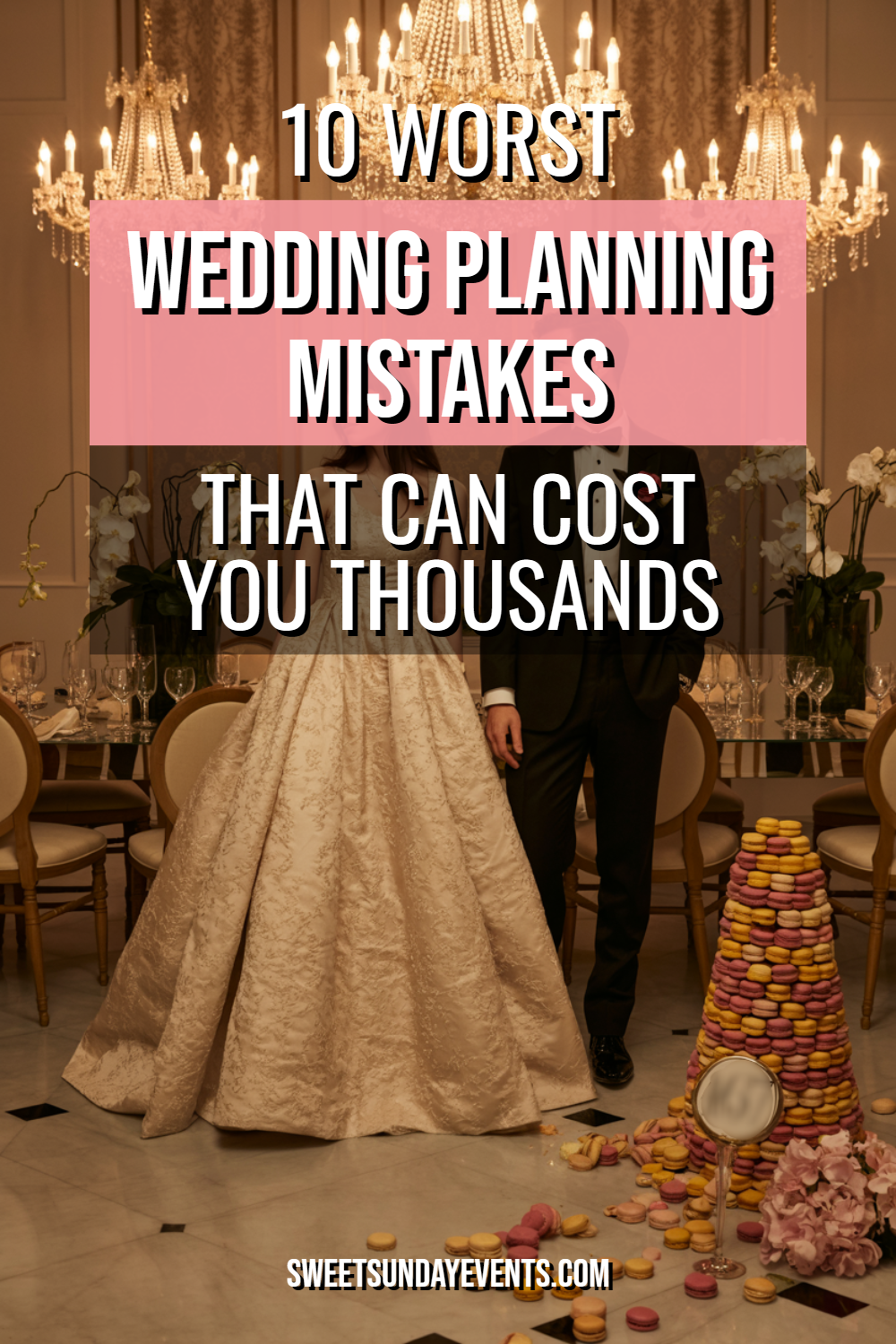Planning a wedding feels magical until you realize you’ve accidentally spent your honeymoon fund on chair covers nobody will remember.
After watching countless couples navigate the treacherous waters of wedding planning, I’ve seen the same costly mistakes repeated over and over.
These aren’t just minor hiccups—they’re budget-busting blunders that can add thousands to your final bill. Let’s dive into the most expensive wedding planning mistakes and how to dodge them like a pro.
1. Booking Your Venue Without Reading the Fine Print
That gorgeous venue photo on Instagram doesn’t tell the whole story. Hidden fees lurk in every contract like wedding planning landmines waiting to explode your budget.
Service charges, overtime fees, cake-cutting costs, and mandatory vendor lists can easily add $2,000-$5,000 to your venue bill. Some venues charge $15 per person just to cut and serve a cake you brought from elsewhere.
| Common Hidden Venue Fees | Typical Cost |
|---|---|
| Service charge | 18-22% of total |
| Overtime fees | $200-500/hour |
| Cake cutting | $3-15/person |
| Corkage fees | $15-35/bottle |
| Setup/breakdown | $300-800 |
Always request a detailed breakdown of all potential charges before signing anything. Ask specifically about fees that might apply if your event runs long or if you need extra setup time.
2. Saying Yes to the Dress Too Quickly
Bridal shops are designed to make you emotional and impulsive. That $3,000 dress suddenly seems reasonable when you’re surrounded by $8,000 gowns and well-meaning friends gasping at how beautiful you look.
Sample sale dresses often need extensive alterations, which can cost $500-$1,500 on top of the dress price. Rush fees for alterations can add another $200-$500 if you’re cutting it close to your wedding date.
Take time to shop around and consider all your options. Online retailers, trunk shows, and off-season sales can save you 40-70% on designer gowns without sacrificing quality or style.
3. Underestimating Guest Count Impact
Every additional guest doesn’t just mean one more dinner plate. They trigger a cascade of costs across every aspect of your wedding.
Adding 20 guests can increase your budget by $1,000-$3,000 depending on your per-person costs. This includes catering, alcohol, rentals, favors, and potentially upgraded venue space.
Create your guest list early and be ruthless about it. Use the “would I have dinner with this person in the next year” test to help make tough decisions about distant relatives and old acquaintances.
4. Falling for Vendor Package Deals
“Package deals” often include services you don’t need bundled with ones you do. Wedding vendors know couples love the illusion of getting everything handled by one company.
Photography packages frequently include engagement sessions, albums, and prints you might not want, inflating the price by $1,000-$2,500. DJ packages might bundle lighting and MC services when you only need music.
Break down every package to see what you actually need. Often, choosing à la carte services from different vendors saves significant money and gets you exactly what you want.
5. Ignoring Seasonal and Day-of-Week Pricing
Saturday weddings in peak season can cost 50-100% more than Friday or Sunday celebrations. Yet many couples automatically assume Saturday is their only option.
Venue rental alone can drop from $8,000 on Saturday to $4,000 on Friday. Vendors often offer 10-30% discounts for off-peak dates because they’re eager to fill their calendars.
| Day of Week | Average Savings |
|---|---|
| Sunday | 20-40% |
| Friday | 10-25% |
| Thursday | 30-50% |
| Monday-Wednesday | 40-60% |
Consider whether your celebration truly needs to be on Saturday. Your guests who really matter will show up regardless of the day.
6. Skipping Wedding Insurance
Nobody wants to think about disasters on their wedding day, but unexpected events can cost tens of thousands of dollars. Vendor bankruptcies, severe weather, and venue closures happen more often than you’d think.
Wedding insurance costs $150-$550 but can protect investments up to $1 million. Without it, you’re personally liable if your photographer goes out of business or your venue floods the week before your wedding.
The peace of mind alone is worth the cost. Plus, many venues now require couples to carry liability insurance, making this less optional than it used to be.
7. DIYing Beyond Your Skill Level
Pinterest makes everything look achievable, but DIY disasters can end up costing more than hiring professionals. Failed centerpieces, lopsided cakes, and amateur photography can’t be undone on your wedding day.
Couples often underestimate the time investment required for DIY projects. That “simple” flower arrangement might take 15 hours and still look homemade in a bad way.
Choose your DIY battles wisely. Save the complex projects for professionals and focus your energy on meaningful touches that showcase your personality without risking major failures.
8. Booking Vendors Without Checking References
Cheap vendors can be expensive mistakes. Unreliable photographers, inexperienced caterers, and fly-by-night planners can ruin your day and leave you with no recourse.
Always check recent references and read contracts carefully. A photographer who charges half the market rate might disappear with your deposit or deliver unusable photos.
Quality vendors invest in insurance, backup equipment, and professional training. These costs are reflected in their pricing, but they’re worth every penny when things go wrong.
9. Overordering Alcohol and Underestimating Service Needs
Alcohol calculations confuse even experienced planners. Overordering by 50% is common, especially when couples buy their own liquor without understanding consumption patterns.
Wedding guests typically drink less than party guests because they’re eating, dancing, and socializing more. One drink per person per hour is usually sufficient, not the two drinks often recommended by liquor stores.
| Guest Count | Beer (bottles) | Wine (bottles) | Spirits (bottles) |
|---|---|---|---|
| 50 guests | 30 | 15 | 3 |
| 100 guests | 60 | 30 | 6 |
| 150 guests | 90 | 45 | 9 |
Don’t forget to budget for bartenders, mixers, ice, and glassware if you’re providing your own alcohol. These “small” costs can add $500-$1,500 to your bar bill.
10. Making Last-Minute Changes and Additions
Wedding planning momentum builds as your date approaches, making it tempting to add “just one more thing” to your celebration. These last-minute additions rarely enhance your day but always inflate your budget.
Upgraded linens, additional floral arrangements, and extra courses seem small individually but can add $2,000-$5,000 in the final weeks. Vendors often charge rush fees for changes made close to your wedding date.
Set a “no new additions” deadline six weeks before your wedding. After that point, focus on executing your existing plans beautifully rather than expanding them.
Moving Forward Without Breaking the Bank
Wedding planning doesn’t have to be a financial nightmare if you stay aware of these common pitfalls. The couples who end up happiest are usually those who prioritized their values over vendor pressure and social expectations.
Your wedding day will be beautiful regardless of whether you spend $15,000 or $50,000. Focus on what truly matters to you as a couple, and don’t let anyone convince you that love requires going into debt.


